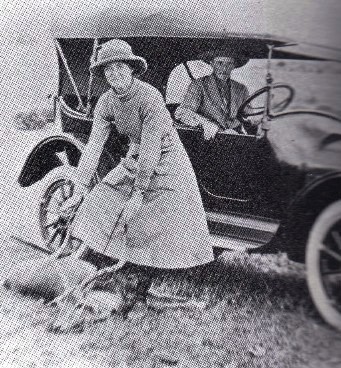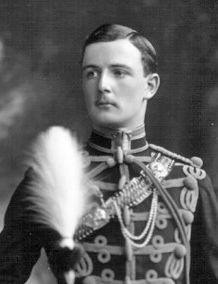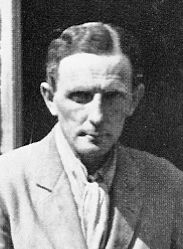Back to search results
Name: COLE, Galbraith Lowry Egerton, Hon.



Nee: 3rd son of the 4th Earl of Enniskillen, bro of Reginald Berkeley Cole
Birth Date: 8.3.1881 Whitegate, Cheshire
Death Date: 6.10.1929 Kekopey, Gilgil, crippling arthritis led to suicide
Nationality: British
First Date: 1903
Last Date: 1929
Profession: Took up land at first at Laikipia but this he relinquished as it was incorporated into a native reserve. In 1906 he obtained a large area of land on the slopes of the Eburru Mountain and Elmenteita Lake.
Area: 'Kekopey', Gilgil, slopes of Eburru Mt. & Lake Elmenteita
Married: In London 7 Dec 1917 Lady Eleanor Balfour b. 4 Sep 1890 Kensington, d. 1986 Hereford
Children: David Lowry 6th Earl of Enniskillen (10 Sep 1918 Nairobi-30 May 1989 Kinloch, Perthshire); Arthur Gerald (15 Nov 1920 London-2005 Nairobi)
Author: Further Bookref: Red Book 1912
Book Reference: Gillett, SE, Best, Random, Midday Sun, Over my Shoulder, Permanent Way, Joelson, Cranworth, Bovill, Mischief, White Man, EAHB 1905, KAD, Red 25, Hut, North, Curtis, Playne, Drumkey, Land, Red 22, EAHB 1906, Burke, Peerage, Eton, EAHB 1907, Mills, Chandle
War Service: Lt. 10th Hus. Boer War
School: Eton & Trinity Cambridge
General Information:
SE - Hon. G. Cole - Ndaragwa - Gilgil - July 1907 On his estate, over the many years he was in the district, he did great work for the development of sheep farming, some of the finest flocks in the country being on his estate. He also built up a very valuable herd of cattle, many of which had been imported. Many acres were put under cultivation and all the chief crops were grown, as well as a large variety of fruit trees. His main hobby was shooting and his reputation of being a first class shot was known throughout the Colony.
Best - Came up against a steeply forested hill where no wheeled vehicle could pass, you did not just turn back - you took your wagon to pieces and manhandled it wheel by wheel up the slope. ........ in the early days hardly ever travelled anywhere but by a landau harnessed to a team of oxen.
Random - 'Galbraith's farm, Kekopey, named after the little river which runs through it, was on the east side of Lake Elmenteita, with Lord Delamere's land and house, Soysambu, on the opposite side. ...... Galbraith lived overlooking the lake in a small house which he had built when he first took up this land about 1905. He first saw Kenya in 1903. At that time, he was suffering from sciatica, contracted during the Boer War. He was planning to go out and shoot mofflon sheep in Persia, when his sister Florence, married to Lord D. in Kenya, or B.E.A. as it was then, had suggested that he should come and visit her on his way. This he agreed to do .......... was soon fascinated with all the problems of developing a new country; he found it much more exciting than big game shooting. Florence had a Dutchman working for her, and from him G. learned how to train, inspan and drive a team of oxen. ....... G. soon decided that he would like to take up land and start farming on his own. He sent in his army papers and applied to the government for a grant of land. He wanted to go out into the blue and be away on his own, so he applied for land in Laikipia at Ndaragwa. D. was employing Masai to herd his cattle, and G. learnt their language and engaged some to come and work for him. When his grant of land came through, he bought a South African wagon and a team of semi-trained oxen, and with his Masai guides, he set off to reach his new land. He must have pioneered the road that is now known as the East Road to Thompson's Falls. He was very thrilled when he first saw the falls - probably the second white man to see them after Thompson. ........... The track which the Masai showed him on the other side, up through the cedar forest, was very steep and very narrow. G. decided that the only way to negotiate it was to take the wagon to pieces, and then for the porters to carry it up wheel by wheel. This, too, was afely achieved. ...... Ndaragwa was about 40 miles from Nyeri. G. threw off his sciatica, and was soon in very strong and good health. He thought nothing of walking in to Nyeri, and he would lift two hundred pound bags on to his wagon with one hand. His Masai friends used to reproach him for doing this, for, they said, "that was a woman's load". ........... Then came a blow; the Government decided that they wanted to make a northern Masai reserve, and warned G. that he would have to give up his holding at Ndaragwa. ...... He was offered land in the Rift Valley in exchange. The only block of land still vacant lay between what was already Delamere's and another block belonging to a Dr. Doering. ....... my first meeting with Galbraith was when our 1916 safari party arrived with the cattle at the house beside the lake. G.'s rheumatic trouble had by this time returned and he was crippled with arthritis in both legs and arms and in his spine. He was unable, in consequence to ride, or walk far, and had acquired an old Ford car. .......... one day during our visit, we went out shooting. I was lent a light rifle. Presently a handsome impala buck presented itself - a good shot - and I was offered the chance to show what I could do. I took careful aim and pulled the trigger. The buck sprang high into the air, and then fell dead, shot through the heart. I did not know until months later how much hung on that shot. G. had said to himself, "If she kills it, our friendship will ripen; if she misses, it will come to nothing." ........... In 1919 G. was garnted a lease of land in Laikipia called 'El Pingwan'. ...... In 1924 due to continuing ill health decided to return to England and bought a property in Gloucestershire. ......... Had to return to Kenya on sudden death of Berkeley Cole in April 1925. ........ travelled back and forth between Kenya and England to find best place for G.'s health. Galbraith died on 6th October 1929.
Midday Sun - 'Galbraith had the ranch next to Soysambu [Delamere's] called Kekopey meaning in Masai 'the place where white comes through green' - a reference to deposits of diatomite later to be mined by the Coles.' ........ 'Galbraith Cole had set eyes on Africa at the age of 19 when his regiment had arrived at the Cape to take part in the Boer War - he fell in love with it. ...... With Delamere's help, he secured a grant of 50000 acres, later exchanged for 30000 acres adjoining Soysambu in the Gilgil district. .......... As well as lions, zebras and diseases, stock-thefts were a major worry. One white policeman and a small force of askaris stationed many miles away were impotent to stop marauders from stealing Galbraith's sheep and eating them on the spot. The law having failed him, he took the law into his own hands. One night he came upon a hut hidden in the bush and surprised inside it 3 Kikuyu men skinning a sheep of the merino, not the native breed. The men fled; Galbraith fired 2 shots after them and one of the men was fatally wounded. Galbraith failed to report the matter to the police. He was tried for murder, for which the penalty was death, by an all-white jury, and acquitted. .......... The Government decided to make an example and the Governor, on orders from Whitehall, issued a deportation order on the grounds that 'the Hon G.L.E. Cole is conducting himself so as to be dangerous to peace and good order in EA and is endeavouring to incite enmity between the people of EA and His Majesty' - a charge which would have been difficult to substantiate. Galbraith left the Protectorate in ignominy and with no prospect of return. This was in Sept. 1911. .... (more) .......... war came to his rescue. His mother pleaded his cause with Lord Harcourt, Sec. of State for the Colonies, and in Oct. 1914 he was back at Kekopey. .......... Galbraith (Llewellyn Powys wrote) might be 'as hard as flint and crafty as a snake, and cold as ice, but by Jove he has a brain and one can say anything to him, and he will switch his brain on to it and ferret it out. He has more intelligence than anybody else in EA and more distinction of mind .......' Never in his life before, Llewellyn added, had he met so strong a character.' .......... One day in October 1929 Nell loaded his revolver and took the dogs for a walk. Jama Farah supported his arm while he raised the revolver to his head.
Cranworth - deportation of Galbraith Cole - one of the most popular inhabitants both with black and white. He had suffered repeatedly from thefts of cattle and sheep ...... One day he caught a party of Masai red-handed driving off his sheep, and, having a rifle, fired a shot to frighten the delinquents. By an unfortunate mischance the shot struck one of the party, who subsequently died. .... The Governor [Sir Percy Girouard] decided it was a case for deportation. ........ It is pleasant to record that in two years Galbraith returned to his farm .... He remained in Kenya many more years, loved and respected by all, till a wasting and painful illness carried him off in what should have been his prime.
White Man - 1904 - Masai move to Laikipia - One or two settlers had already established themselves in Laikipia. They were moved off and given land elsewhere. One of these was Galbraith Cole who had trekked up over the escarpment in 1903, taking his wagons to pieces, carrying them up by hand and reassembling them again at the top. So far as is known he was the second European to reach Thomson's Falls. ............. 1911 ....... Galbraith's deportation (pp. 281 on) ...... during the war he was smuggled back into the Protectorate, disguised as a Somali, by some friends, and subsequently (crippled with arthritis) he was allowed to stay.
Curtis - p. 88 - 'Lady Eleanor Cole at Kekopey' - 'After war service in South Africa the Hon. Galbraith Cole, son of the Earl of Enniskillen, came to BEA in 1903 to stay with his sister, Lady Delamere, at Elmenteita. For a while he helped to run their farm, meanwhile learning to speak Maasai. In due course he decided to settle and bought land in Laikipia. .......... Cole lost his farm when the Govt. turned Laikipia into a northern Maasai reserve ( a decision reversed by the Maasai move of 1911/12). He was offered a choice of holding elsewhere, and chose land at Elmenteita near his brother-in-law. Kekopey was a stretch of dry country with a boundary on the Kariandus River. In 1916 Galbraith Cole met Lady Eleanor Balfour, who was on a visit to her cousin Mrs Milne, the wife of BEA's Principal Medical Officer. They were married in London in 1917. Lady Eleanor writes:- 'My husband and I came back to Kenya at the beginning of 1918. ......... After we moved into our house my husband had a terrible go of dysentery. For 2 months he hung between life and death. Then came the Spanish flu ......…
Playne - Sheep-farming on a huge scale is being indulged in by the Hon. G.L.E. Cole, who came to BEA in 1903 for 6 months to shoot, and later took up land at Laikipia for 2 years. This was given up owing to a Native Reserve being made there. In 1906 Mr Cole acquired the present farm, which is situated on the slopes of the Eburru Maountain and Elmenteita Lake, and is in extent about 25000 acres, composed of hill and plain land. He has also some 11000 acres in Mount Kenia district, to be used for the purpose of sheep breeding later on. There is a stone dwelling-house, from which a splendid view of the surrounding country is obtained. The water and timber supply are both excellent. Hot springs at which a bath is in the course of erection, lie not far from the homestead. ...... There is a large quantity of game on the farm, but the vermin has to a large extent been killed off. ..…
Land - Hon. G. Cole leased 19942 acres at Gilgil
Land - J.B. van der Weyer leased 9950 acres at West Kenya, passed to Hon. G. Cole
Red 22 - Honorary Permit Issuer - Karriandus, Gilgil
Land - 1908 - The Hon. G. Cole - Grazing, 11200 acres, Guaso Nyiro and Narrumurru Rivers, 24-6-04, Registered 11-11-08 Land - 1907 - G. Cole - Grazing, 20,288 acres, Elmenteita Lake, 24-6-04, Registered 30-11-07
Mills - John Henry Michael Cole, 5th Earl of Enniskillen (1877-1963), then Lord Cole, and his 2 younger brothers, Hon. Galbraith Lowry Egerton Cole (1881-1921) and Hon. Reginald Berkeley Cole (1882-1925) all served in the Boer War from 1901-1902 - a remarkable family feat. ………..
Red Book 1912 - G. Cole - Naivasha
Gazette - 3/12/1919 - Register of Voters - Rift Valley Area - Hon'ble G.L.E. Cole - Farmer - Gilgil
Gazette - 20/5/1930 - Probate and Administration - The Hon. Galbraith Lowry Egerton Cole who died at Gilgil on 6 October 1929
Back to search results



